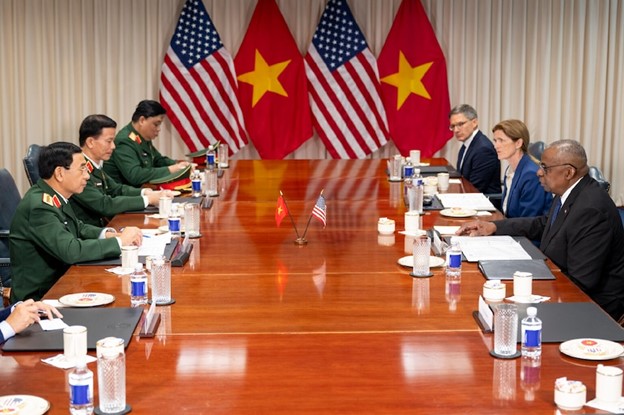In June of 2024, Hunter Biden, the son of President Joe Biden, was convicted of three federal felony charges after a jury trial in a Federal District Court in Wilmington, Delaware. According to the Associated Press, “Jurors found Hunter Biden guilty of lying to a federally licensed gun dealer, making a false claim on the application by saying he was not a drug user and illegally having the gun for 11 days.”
At that time, the AP also noted that “President Joe Biden said in a statement issued shortly after the verdict that he would accept the outcome and ‘continue to respect the judicial process as Hunter considers an appeal.’”
In September, the President’s son plead guilty to three felony tax charges, as well as six misdemeanor charges in a Los Angeles federal court. The US Attorney’s Office stated that “Hunter Biden engaged in a four-year scheme in which he chose not to pay at least $1.4 million in self-assessed federal taxes he owed for tax years 2016 through 2019 and to evade the assessment of taxes for tax year 2018 when he filed false returns.”
Since this second conviction, President Biden has stated, either through his Press Secretary or in person, that he would not use his Presidential power to issue a pardon for his son. For instance, “[i]n July [of 2023], Fox News’ Mark Meredith asked Jean-Pierre if there was any possibility Biden would end up pardoning his son as Hunter was facing two counts of willful failure to pay federal income tax. ‘No,’ Jean-Pierre simply said. She also interrupted an attempted following up question saying, ‘I just said no,’ before moving on to another reporter.”
In June of 2024, “President Joe Biden said he would not pardon his son Hunter amid an ongoing felony gun trial during a[n]…exclusive interview with ABC News anchor David Muir at the Normandy American Cemetery on the 80th anniversary of D-Day. Muir asked Biden…if he would accept the outcome of his son’s trial in Wilmington, Delaware, to which the president said, ‘Yes.’ Biden also said ‘yes’ when asked by Muir if he would rule out a pardon for Hunter.”
Many in the media took Biden at his word. As described by the Daily Mail, “MSNBC host and Biden’s former press secretary Jen Psaki described the President’s decision as evidence of his principled honor and character. ‘[T]he justice system that convicted his only surviving son is the same justice system he vowed to protect,’ Psaki said in June. ‘If that doesn’t tell you who Joe Biden is, I don’t really know what does.’ MSNBC host Mika Brzezinski cited Biden’s decision as evidence that he was a more respectful president than former President Donald Trump. ‘The current president of the United States has so much respect for the law that he has said he would not pardon his son, again, it’s all about the contrast,’ she said.”
A man who has “vowed to protect” the justice system. A man with “respect for the law.” A man who said, in no uncertain words that he would “accept the outcome” of his son’s trial and “continue to respect the judicial process.” This is the man Psaki, Brzezinski and Jean-Pierre would have you believe is the real Joseph Biden.
But most of us know better. Most of us who have followed the corrupt history of the Biden crime family know better. And knowing better, are any of us really surprised that Joe Biden lied through his teeth to the American people about pardoning his son before his term as President expires?
“President Joe Biden announced Sunday [December 1] that he has pardoned his son Hunter Biden, who faced sentencing this month for federal tax and gun convictions…’Today, I signed a pardon for my son Hunter,’ the president said in a statement. It is a ‘full and unconditional pardon,’ according to a copy of the executive grant of clemency…The pardon means Hunter Biden won’t be sentenced for his crimes, and it eliminates any chance that he’ll be sent to prison, which was a possibility…The broadly crafted pardon explicitly grants clemency for the tax and gun offenses from his existing cases, plus any potential federal crimes that Hunter Biden may have committed ‘from January 1, 2014 through December 1, 2024.’ This time frame, importantly, covers his entire tenure on the board of Ukrainian gas company Burisma and much of his other overseas work, including in China.”
Yes, we on the right knew Biden was nothing more than a liar, but the outrage expressed by Republican members of Congress, while predictable, was still necessary to highlight Biden’s hypocricy. As reported by Fox News, “[o]n the heels of President Joe Biden’s move to pardon his son Hunter Biden, several Republican lawmakers highlighted a post on X from earlier this year in which the president had asserted, ‘No one is above the law.’ Reps. Tom Emmer, R-Minn., and Eli Crane, R-Ariz., both shared Biden’s post and commented, ‘Unless your last name is Biden’…’You’ve been lied to every step of the way by this Administration and the corrupt Biden family. This is just the latest in their long coverup scheme. They never play by the same rules they force on everyone else. Disgraceful,’ Rep. Steve Scalise, R-La., declared in response to the old Biden tweet.”
The sweeping nature of the pardon gave rise to the inevitable comparisons with Gerald Ford’s pardon of Richard Nixon. According to Politico, “’I have never seen language like this in a pardon document that purports to pardon offenses that have not apparently even been charged, with the exception of the Nixon pardon,’ said Margaret Love, who served from 1990 to 1997 as the U.S. pardon attorney, a Justice Department position devoted to assisting the president on clemency issues…rather than merely pardoning his son for the gun crimes for which he was convicted and the tax crimes for which he pleaded guilty, the president’s pardon covers all ‘offenses against the United States which he has committed or may have committed or taken part in’ from Jan. 1, 2014, through Dec. 1, 2024. That language mirrors the language in Ford’s pardon of Nixon, which did not merely cover the Watergate scandal but extended to ‘all offenses against the United States’ that Nixon ‘has committed or may have committed’ between Jan. 20, 1969, and Aug. 9, 1974 – the exact span of Nixon’s presidency.”
Republican Ford’s pardon of Republican Nixon is not the only controversial pardon to have occurred before this one. As described by Time, “[i]n 1983, financier Marc Rich was indicted for evading more than $48 million in taxes, and charged with 51 counts of tax fraud, as well as running illegal oil deals with Iran during the 1979-1980 hostage crisis. During his last week in office, President Bill Clinton pardoned Rich, who had fled the U.S. during his prosecution and was residing in Switzerland. Clinton’s eleventh-hour move…outraged Republicans and Democrats alike. The Rich pardon sparked an investigation into whether it was bought by the hefty donations Rich’s ex-wife, Denise, had given to the Clintons and the Democrats. In the end, investigators did not find enough evidence to indict Clinton.”
Washington Post columnist EJ Dionne spoke with one of the original Rich prosecutors, Martin Auerbach. “’I voted for Clinton three times,’ said Auerbach, who…was referring to his presidential votes in 1992 and 1996, and his ballot for Hillary Clinton in [2000’s] Senate contest. ‘I’ve defended Clinton for years. I always felt that the rules had changed around him. But this creates a whole different question in my mind.’ The problem with Rich is that ‘he thumbed his nose at the law every single time the country responded to a crisis,’ whether the matter was the energy crisis or the hostage crisis in Iran. ‘You may think tax rates are too high,’ Auerbach said. ‘But to unilaterally evade taxes on $100 million is not the way to go.’ Auerbach, still a political progressive, offers what should be a very troubling observation for liberals. ‘Think of all the kids who hot-wire cars and go to jail. They don’t get to choose between going behind bars or spending a rather comfortable exile.’ And he adds: ‘I sure would like an explanation from the former president: What was he thinking?’”
Its pretty obvious, given the donations made by Rich’s wife to Team Clinton, what Bill was thinking. Its also just as obvious what “Big Guy” Biden was thinking when he pardoned his son (and bagman) Hunter. According to the woman he hired to lie for him, Press Secretary Karine Jean-Pierre, “‘One of the reasons the president did the pardon is because they didn’t seem like his political opponents would let go of it. It didn’t seem like they would move on,’ she told reporters on Air Force One during a trip to Angola. ‘They would continue to go after his son. That’s what he believed.'”
This effort to protect his son may have been yet another miscalculation by President Biden. According to the Denver Gazette, “Hunter Biden may no longer have the Fifth Amendment right to remain silent if called to testify under oath for his actions over the past 11 years after President Joe Biden pardoned the first son, legal experts say…[u]nder the Fifth Amendment, people can refuse to answer questions if their responses might incriminate them in criminal cases. However, with all criminal liability now erased by the pardon, Hunter Biden could face contempt charges if he refuses to testify before congressional panels. ‘Well, this now makes it much easier for a GOP Senate/House to call Hunter as a witness about his and his dad’s connections to Ukraine, etc. because the pardon prevents Hunter from asserting the Fifth Amendment right not to incriminate himself,’ Mark Smith, a constitutional attorney and host of the Four Boxes Diner legal analysis show, wrote on X.”
Of course, this theory is predicated on Congressional investigations of the Biden Presidency continuing under a Trump Presidency, something many of us expect to occur. There is also a chance that Donald Trump will concentrate on the economy, controlling illegal immigration, preventing a spread of the wars in the Ukraine and Israel, and not have time to encourage Congressional action against his Democrat enemies.
Regardless, there is one concept involved here that is no theory – the President of the United States does have the power to grant this pardon to anyone, including his son.
Under Article II, Section 2, Clause 1 of the United States Constitution, “[t]he President…shall have Power to grant Reprieves and Pardons for Offences against the United States, except in Cases of Impeachment.” As described at Constitution Annotated, “[t]he power, which has historical roots in early English law, has been recognized by the Supreme Court as quite broad. In the 1886 case Ex parte Garland, the Court referred to the President’s authority to pardon as unlimited except in cases of impeachment, extending to every offence known to the law and able to be exercised either before legal proceedings are taken, or during their pendency, or after conviction and judgment. Much later, the Court wrote that the broad power conferred in the Constitution gives the President plenary authority to ‘forgive’ [a] convicted person in part or entirely, to reduce a penalty in terms of a specified number of years, or to alter it with certain conditions.”
Constitution Annotated does note that besides a Presidential pardon not being available for those who have been impeached, “clemency may only be granted for Offenses against the United States, meaning that state criminal offenses and federal or state civil claims are not covered.” Further, “the [Supreme] Court has indicated that the power may be exercised at any time after [an offense’s] commission, reflecting that the President may not preemptively immunize future criminal conduct.”
Thus, President Biden has the authority to give his son immunity for any crimes committed between 2014 and 2024, but not for any future federal crimes. Biden also cannot pardon Hunter for any State level criminal charges. This interpretation is also supported by the US Attorney’s Office, Office of the Pardon Attorney, who state clearly that “the President’s authority to grant clemency is limited to federal offenses…[a]n offense that violates a state law is not an offense against the United States.”
This does tend to raise a question. While Biden’s pardon of Hunter should cover any state charges predicated on violations of federal law, many federal crimes have state law counterparts. For instance, in violating federal income tax reporting laws, Hunter Biden probably also violated Delaware state tax reporting laws. Could then a Delaware State Prosecutor bring charges against Hunter Biden for these violations of state tax law?
Based upon the limitations placed upon the Presidential Pardon Power described above, the answer should be yes, so long as the Statute of Limitations has not expired for these charges. But in reality, the local prosecutor in Wilmington, Delaware, Jack Stollsteimer, is a Democrat who has reportedly received funding for his campaign from George Soros. How likely would Stollsteimer be to prosecute the son of soon to be former President Joe Biden?
Thus, while we acknowledge that Joe Biden has the authority to give his son clemency, we are left with the uncomfortable feeling that this pardon is an abuse of that authority, especially after telling the American people he would do no such thing. We are left with the same feeling that Martin Auerbach had after watching his political idol, Bill Clinton, pardon a man who “thumbed his nose” at the law while “kids who hot wire cars go to jail.” The same unhappy feeling those on the left had watching Ford pardon Nixon.
But at the same time, we who have studied the career of Joe Biden are not surprised. We know Joe Biden to be a disreputable criminal who had no business being President of the United States. We know that his son is also a criminal who has enjoyed the protection of his powerful father for years.
The only surprise here is that Joe Biden cares so little for his legacy, that he is willing to go down in history as a abject liar, with a word that’s worth less than that of his Press Secretary, and a hypocrite, who dared to claim no one is above the law, while placing his son…beyond the reach of justice.
Judge John Wilson served on the bench in NYC









